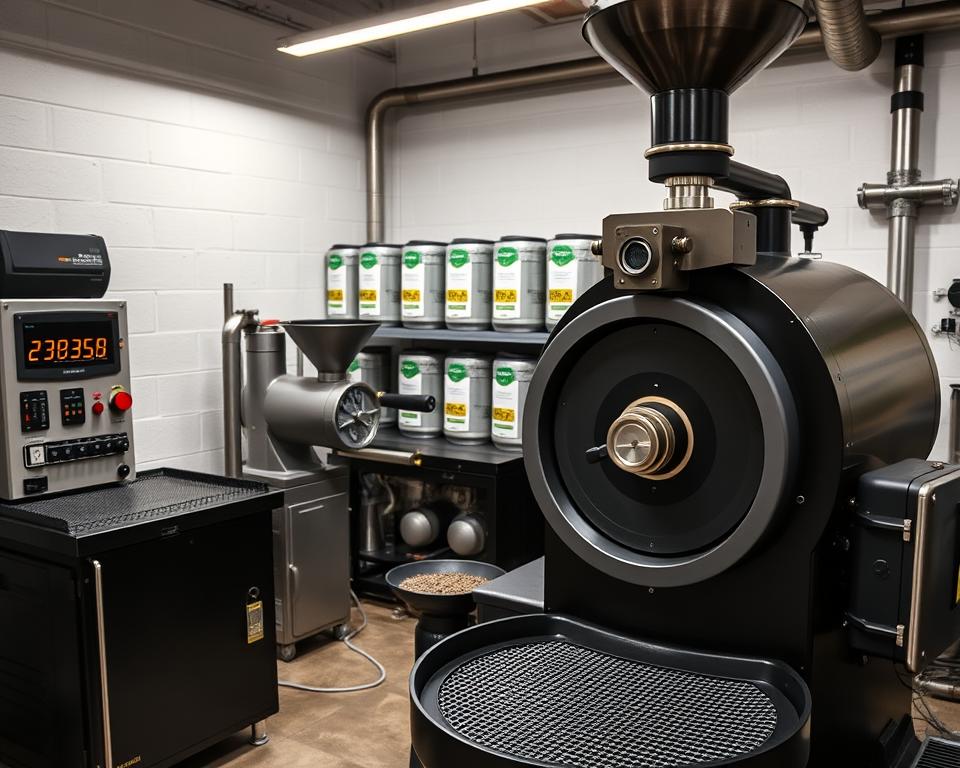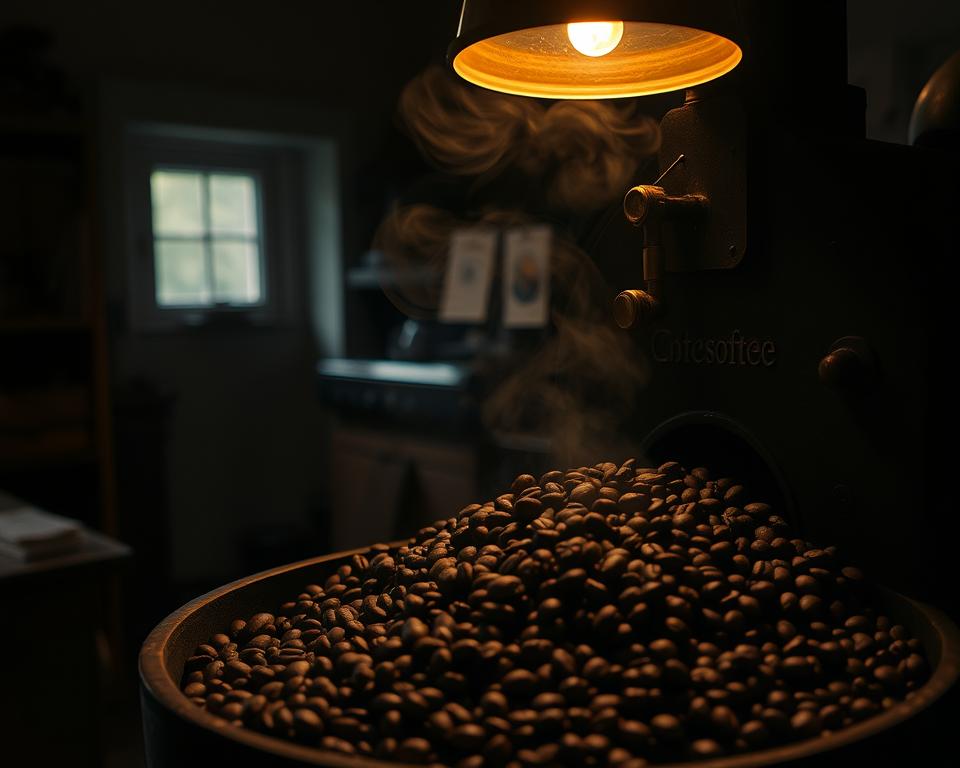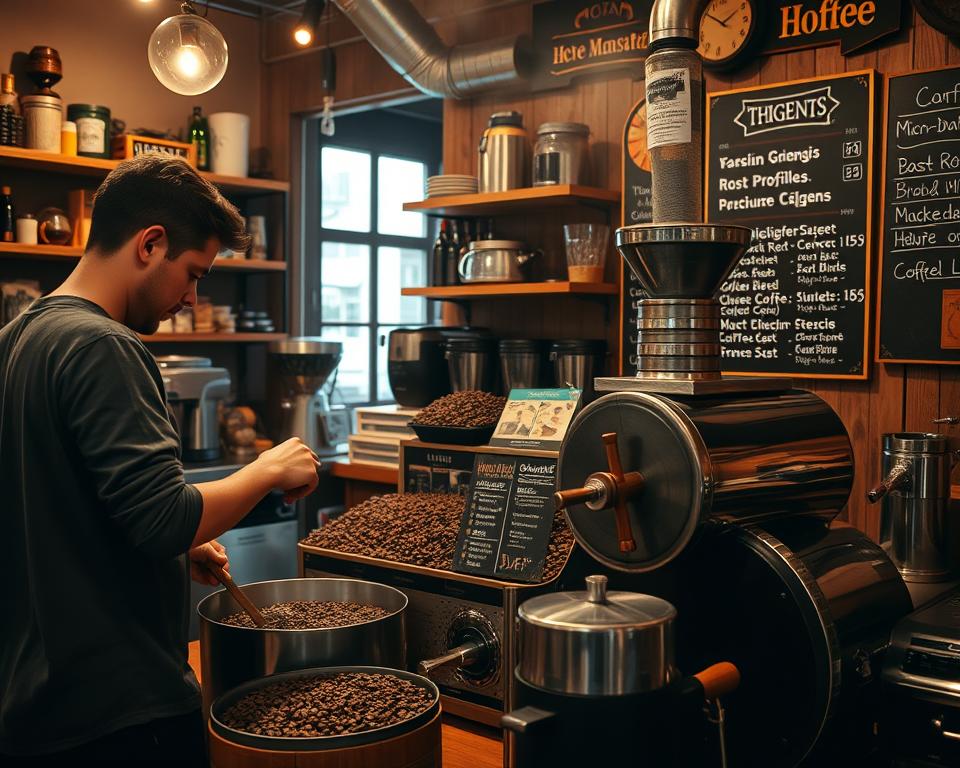Micro-roasting has become increasingly popular among coffee aficionados. It involves roasting small batches of coffee beans to highlight each bean’s unique flavors and characteristics. This method produces a more nuanced and complex taste profile. It’s a cornerstone of the specialty coffee world, closely tied to small-batch roasting. For those eager to dive into micro-roasting, home coffee roasting guides are an excellent starting point.
Micro-roasting opens up a world of flavors and aromas not achievable through traditional commercial roasting. It offers a level of control and precision that results in a personalized coffee experience. Whether you’re a connoisseur of specialty coffee or simply curious, exploring micro-roasting is a worthwhile endeavor.
Key Takeaways
- Micro-roasting involves roasting small batches of coffee beans to bring out unique flavors and characteristics.
- Micro-roasting is a key part of the specialty coffee industry and is often associated with small-batch roasting.
- Micro-roasting allows for a higher level of control and precision, resulting in a more nuanced and complex flavor profile.
- Coffee lovers can experience a wide range of flavors and aromas with micro-roasting that are not possible with traditional commercial roasting methods.
- Micro-roasting is a great way to try something new and unique in the world of specialty coffee.
- Resources such as home coffee roasting guides can provide more information on micro-roasting and how to get started.
What is Micro-Roasting?
Micro-roasting involves roasting small batches of coffee beans, usually 150 pounds or less. This method allows for greater control and precision, much like craft breweries and small-batch chocolatiers. Springline Coffee highlights how micro-roasting emphasizes quality over quantity, leading to a more nuanced flavor profile.
At the core of micro-roasting are premium beans sourced globally. Beans from East Africa might have vibrant berry and wine notes, while Latin American beans could hint at nuts and cocoa. The micro-roasting process brings out these delicate flavors, which can be overshadowed in darker roasts. This is crucial for artisan coffee lovers who seek unique and exotic tastes.
Micro-roasting offers several advantages, including higher quality control and the ability to highlight unique flavors. It often involves roasting coffee to order, ensuring freshness and nuanced flavors. This approach ensures that every bean has a specific purpose and consumer, reducing waste and energy consumption. By opting for a coffee roastery that specializes in micro-roasting, coffee aficionados can fully appreciate the range of flavors that high-quality, premium beans offer.
The History of Coffee Roasting
Coffee roasting’s history stretches back to the 15th century, starting in the Middle East. Over time, it spread globally, with each region crafting its unique roasting style. The tradition of hand-crafted roasting has been cherished for generations, with each area adding its own flair.
In Yemen, coffee beans were first roasted in metal pans over open fires. This marked the start of coffee roasting’s tradition. The 19th century saw improvements with the introduction of thermometers, timers, and gauges. These tools enabled more precise roasting, leading to the creation of single origin coffee.
Today, coffee roasting is an art that focuses on selecting and roasting top-quality coffee beans. The rise of micro-roasting has introduced a variety of unique coffee flavors. Whether you prefer traditional or modern roasting, coffee’s rich history and cultural importance are undeniable.
The evolution of coffee roasting has introduced various methods, like infrared and fluid bed roasting. These techniques offer greater control over the roasting process. This results in a more precise and consistent flavor. The growing demand for specialty coffee has made high-quality beans and expertly roasted coffee more sought after than ever.
Choosing the Right Beans for Micro-Roasting
Micro-roasting demands the selection of the finest coffee beans to unveil unique flavors. Springline Coffee highlights the importance of origin, flavor profile, and green bean quality. These elements significantly influence the coffee’s final taste and aroma. For specialty coffee, the region and farm of origin are critical, as they determine distinct flavor profiles.
Micro-roasted coffee is roasted in batches under 150 pounds, fostering a detailed roasting approach. This method allows micro-roasters to accentuate each bean’s unique traits, leading to a more complex and flavorful brew. High-quality green beans are essential for crafting a unique and delectable coffee experience.
Key considerations for bean selection in micro-roasting include:
- Origin: Arabica beans from high-altitude regions offer a more delicate flavor, while Robusta beans from lower altitudes have a bolder taste.
- Flavor profile: Beans from different regions exhibit distinct flavors, ranging from sweet and soft to sharp and tangy.
- Green bean quality: The quality of the green beans directly affects the coffee’s final flavor and aroma.
Understanding these factors and selecting the right beans enables micro-roasters to craft unique and delicious coffee experiences. Small-batch roasting opens up endless possibilities for experimentation and innovation. It allows micro-roasters to explore new flavors and aromas, pushing the boundaries of specialty coffee.
Equipment Needed for Micro-Roasting
To start a coffee roastery, having the right equipment is crucial. This includes a high-quality roaster, ranging from small-batch drum roasters to fluidized bed roasters. The choice depends on the micro-roaster’s specific needs and goals.
Alongside the roaster, essential accessories like a thermometer and cooling tray are vital. They ensure beans are roasted to the perfect temperature and cooled quickly. Other must-haves include a scale, stirring spoon, and extension cord. For those focused on artisan coffee, the right equipment is key to producing top-notch coffee.
Some popular equipment options for micro-roasting include:
- Drum roasters, which can range from 2 to 12 pounds in capacity
- Fluidized bed roasters, which offer precise temperature control
- Cooling trays, which help to quickly stop the roasting process
- Thermometers, which ensure accurate temperature measurement

Investing in the right equipment allows coffee roasters to produce high-quality, hand-crafted coffee. With the right tools and practice, anyone can become a skilled micro-roaster. Enjoying the perfect cup of coffee becomes a reality.
Steps to Master Micro-Roasting
To excel in micro-roasting, one must grasp the intricacies of the process and the techniques it entails. This small-batch roasting method is pivotal for crafting unique flavors and ensuring superior quality. Micro Espresso emphasizes that mastering this craft requires a blend of pre-roasting preparation, roasting techniques, and consistent practice.
Pre-roasting preparation is paramount. It involves cleaning and sorting the beans, and calibrating the roaster to the ideal temperature and settings. This foundational step is essential for producing top-tier specialty coffee. The actual roasting process demands vigilant monitoring of temperature, time, and other variables. This ensures the beans reach their peak flavor and aroma.
- Bean origin and quality
- Roast level and temperature
- Roasting time and technique
Through experimentation with various roasting techniques and regular practice, micro-roasters can hone their skills. This enables them to create distinctive flavors and high-quality specialty coffee. With the appropriate equipment and mastery of techniques, anyone can refine their micro-roasting skills. This leads to the perfect cup of coffee.
Flavor Development in Micro-Roasting
In the realm of micro-roasting, the art of flavor development distinguishes artisan coffee from its mass-produced counterparts. This process delves into the Maillard reaction, a chemical transformation that occurs when premium beans are roasted. It leads to the creation of new flavor compounds and enhances the coffee’s aroma.
A coffee roastery excelling in micro-roasting can unlock the beans’ full flavor and aroma potential. The roast level significantly influences the taste, with lighter roasts showcasing acidic and fruity notes. In contrast, darker roasts reveal bitter and sweet undertones.
Several elements shape the flavor in micro-roasting:
- Roast level: Lighter roasts retain delicate flavors and acidity, while darker roasts unveil bolder tastes.
- Roast time: The duration of roasting impacts the flavor, with shorter times enhancing acidity and longer times deepening the taste.
- Bean origin: The origin of the premium beans profoundly affects the flavor, with different regions offering unique notes.
By grasping these elements and honing the micro-roasting craft, a coffee roastery can craft exceptional, distinctive artisan coffee. This showcases the true potential of the premium beans.
Tips for Beginners in Micro-Roasting
For those new to micro-roasting, it’s vital to steer clear of common pitfalls. Over-roasting can lead to a bitter taste, while under-roasting results in sourness. To sidestep these issues, start with small batches and explore various roasting methods and settings.
Quality is key in hand-crafted roasting. Choose high-quality single origin coffee beans. Green beans can stay fresh for up to a year if stored correctly. Roasting temperatures vary, from 350°F to 500°F, depending on the method. The first crack, signaling a light roast, usually happens in the first 3-5 minutes.
Here are some tips for beginners in micro-roasting:
- Start with small batches to experiment with different roasting techniques and settings
- Use high-quality single origin coffee beans for hand-crafted roasting
- Store green coffee beans in proper storage containers to maintain freshness
- Allow beans to de-gas for at least 12 hours before sealing for storage
By adhering to these guidelines and practicing often, beginners can enhance their micro-roasting abilities. It’s also important to taste a variety of coffees. This includes light, dark roasts, and everything in between. Doing so will help develop your sensory skills and grasp the impact of coffee selection and roasting on the final product.
Micro-Roasting versus Commercial Roasting
The roasting process significantly impacts coffee’s flavor and quality. Micro-roasting, which roasts small batches under 150 pounds, offers distinct advantages over commercial roasting. It allows for precise control, leading to unique flavors and a richer taste experience.
Commercial roasting, in contrast, roasts large batches, resulting in less nuanced flavors. This method often employs automated processes, lacking the precision of micro-roasting. Skilled individuals oversee micro-roasting, ensuring the best flavors are extracted from the beans.
Micro-roasting excels in creating specialty coffee with unique profiles. It fosters experimentation and innovation, allowing roasters to explore new flavor combinations. This approach is also more sustainable, requiring less energy and resources. For more insights, visit micro-roast coffee FAQs and explore the realm of small-batch roasting.
Key differences between micro-roasting and commercial roasting include:
- Batch size: Micro-roasting roasts small batches under 150 pounds, while commercial roasting handles hundreds of pounds.
- Level of control: Micro-roasting offers more control and precision, resulting in unique flavors and complex profiles.
- Sustainability: Micro-roasting is more sustainable, requiring less energy and resources.

Building Your Micro-Roasting Community
The micro-roasting industry is booming, and connecting with others is crucial. Joining local coffee roastery groups and attending artisan coffee festivals is essential. These events allow you to learn from experts, share your experiences, and build relationships with fellow roasters.
Online platforms also play a significant role in expanding your network. Social media groups and coffee-focused forums are great for connecting with a wider audience. They keep you informed about industry trends and help solve any challenges you face.
Engaging with both local and online communities can greatly benefit your skills and knowledge. It also contributes to the growth of the industry. As the coffee roastery world evolves, building camaraderie and collaboration is vital for the success of micro-roasters.
FAQ
What is micro-roasting?
What are the benefits of micro-roasting?
How does micro-roasting differ from traditional coffee roasting?
What factors should be considered when choosing beans for micro-roasting?
What equipment is necessary for micro-roasting?
What are the key steps to mastering micro-roasting?
How does the Maillard reaction affect flavor development in micro-roasting?
What are some common mistakes to avoid for beginners in micro-roasting?
How does micro-roasting compare to commercial roasting?
How can I build a micro-roasting community?

Tina Avila is a writer at WyNeeds, where she delves into the rich and diverse world of coffee. With a passion for flavors and brewing techniques, she brings insightful articles covering everything from coffee culture and bean origins to expert tips on making the perfect cup. Her goal is to inspire and educate coffee enthusiasts, helping them enhance their appreciation for every sip.

